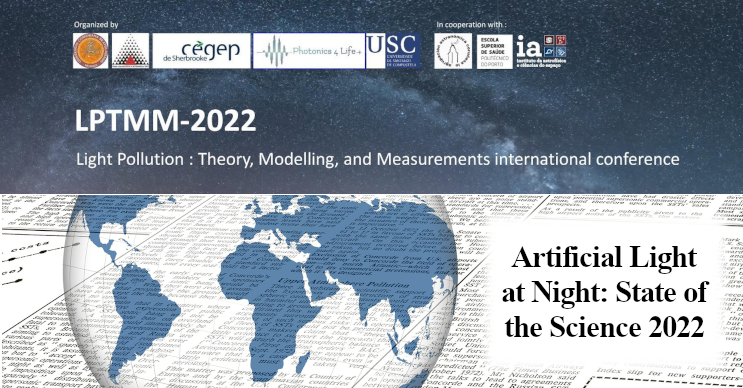Archives
June 2024
Categories
All
|
Back to Blog
Dark sky science updates7/1/2022 Credit: LPTMM/IDA 880 words / 4 minute read This month we shine a figurative spotlight on scientific research into light pollution and dark skies. As a field of academic study, it is growing fast. In the past decade it has brought researchers together across many different disciplines and spawned its own conference series. Two events in June highlight how prominent light pollution research has become. We recap them here. Light Pollution: Theory, Modeling and Measurement (LPTMM) 2022LTPMM is a series of scientific conferences that began in 2013. It alternates years with the Artificial Light at Night (ALAN) series. The COVID-19 pandemic pushed both conferences online in recent years, which enables more people to take part. LPTMM 2022 was held during 21-24 June with over 100 participants. A new feature of this year's meeting was a "roundtable" discussion at the start of the first three days. Instead of a single plenary speaker, the organizers invited short, expert presentations on three topics representing challenges of the next ten years: measuring and monitoring light pollution; the environmental sciences; and public health. Open discussions among all participants followed. The expert presentations highlighted the seriousness of the global light pollution threat. Franz Hölker (Leibniz-Institute of Freshwater Ecology and Inland Fisheries, Germany) noted that light pollution is now widespread and represents "a significant threat to global biodiversity". Prof. Kevin Gaston (University of Exeter, UK) compared light pollution to climate change in the sense of how much it is disrupting the environment. "Things are happening at very low levels of light," he said in reference to that biological disruption. There is no known 'break point' below which we shouldn't be concerned. We heard some interesting science talks as well. These included reports on new advances in measurement of light pollution. In addition to new sensors that look in many directions at once, there are recent innovations in putting cameras on drones and balloons. The National Park Service's Natural Sounds and Night Skies Division introduced a new website that serves its many measurements made on protected public lands. And the creators of GAMBONS, an online model of natural night sky brightness, showed a new version of their website incorporating data from the European Space Agency's 'Gaia' mission. Other researchers are working in subjects in and around lighting science. Sibylle Schroer (IGB) stressed the need to consider "sufficiency" of lighting and not focus exclusively on energy efficiency. To that end, Prof. Salva Bará (Agrupación ÍO, Galicia) showed results of a calculation indicating that, in a perfect outdoor lighting installation, the average viewer only senses about one out of every 22 million photons. The need for more efficient lighting design is very clear. Some recurring ideas emerged during the meeting: (1) There seemed to be a broad consensus that a need exists to standardize what we measure and in which units. Although there is yet no agreement on those points, researchers see the value of doing so, especially to be able to better inform policy makers. (2) We need to get a better handle on the actual amount of outdoor light exposure participants in health studies receive. Most current efforts estimate this from satellite measurements of light pollution. (3) Researchers should take a broader view of the impacts of light pollution on the natural environment. Prof. Gaston referred to this as a 'macroecology' of artificial light at night. That involves better predicting the large-scale ecological impacts of light at night; determining how light pollution interacts with other pressures like climate change; and better understanding which kinds of lighting mitigations work best to reduce ecological impacts. Researchers and activists will next meet at the 8th International Conference on Artificial Light At Night, to be held in Calgary, Canada, next August. IDA 'State Of The Science' ReportWe recently worked with the International Dark Sky Association (IDA) to author a report summarizing what we know about the science of light pollution. The report, "Artificial Light at Night: State of the Science 2022" was the result of two years of work.
We surveyed almost 4,000 scientific papers and reports in the Artificial Light At Night Research Literature Database. The goal of the report is to empower dark-sky advocates and the public with reliable, factual, understandable information about light pollution. The report condenses the current scientific consensus on how artificial light affects seven key topics. These are the night sky; wildlife and ecology; human health; public safety; energy use and climate change; social justice; and satellite light pollution. Where gaps exist in our knowledge, we highlighted them as targets of future research. "State Of The Science" finds the world transformed by electric light in less than 150 years since its introduction. Evidence exists for significant impacts in all the topical areas covered by the report. But it also identifies instances where the evidence is ambiguous and requires further scrutiny. We used illustrations from the papers we cite to make certain points clearer. Also, we wrote the report in language that avoids jargon to make the contents understandable to more readers. Besides its value to dark-sky advocates in their education and outreach efforts, the report is suitable as a "leave-behind" for lawmakers and their staffers. For a closer look at how and why we created this report, click here to watch a March 2022 presentation to the IDA advocate community.
0 Comments
Read More
|
 RSS Feed
RSS Feed


